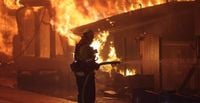Wildfires have always been a part of Earth’s natural cycle, but in recent years, their scale and devastation have reached levels that alarm scientists, governments, and communities across the globe. A sweeping new study published in Science on October 2, 2025, paints a sobering picture: the world’s most damaging wildfires are now occurring about 4.4 times more often than they did in the 1980s, driven largely by human-caused climate change and the growing number of people living near fire-prone wildlands.
This research, conducted by an international team of fire scientists from Australia, the United States, and Germany, analyzed the 200 most economically and humanly catastrophic wildfires since 1980. Instead of focusing on acres burned—a common but sometimes misleading metric—the team zeroed in on economic damage relative to each country’s Gross Domestic Product, adjusted for inflation, and the human toll of each disaster. The result was a new way to spotlight the fires that truly matter to society: those that destroy homes, infrastructure, and lives.
“It shows beyond a shadow of a doubt that we do have a major wildfire crisis on our hands,” said lead author Professor Calum Cunningham, a pyrogeographer at the University of Tasmania’s Fire Centre, in comments reported by the Associated Press and echoed by UC Merced News. The numbers are stark: nearly 43% of the 200 most damaging fires occurred in just the last decade. In the 1980s, the world averaged two catastrophic fires per year, occasionally reaching four. But from 2014 to 2023, that average soared to nearly nine per year, peaking at 13 in 2021.
The study’s findings highlight a pivotal shift starting in 2015, when the frequency of these devastating wildfires began to climb sharply. This turning point, the researchers note, coincided with increasingly extreme climatic conditions—a trend they directly link to the burning of fossil fuels and global warming. “We’ve firstly got that connection that all the disasters by and large occurred during extreme weather. We’ve also got a strong trend of those conditions becoming more common as a result of climate change. That’s indisputable,” Cunningham told the AP. “So that’s a line of evidence there to say that climate change is having a significant effect on at least creating the conditions that are suitable for a major fire disaster.”
Europe and North America have borne the brunt of these disasters, according to the study. The Mediterranean basin—particularly Greece, Italy, Spain, and Portugal—along with California and other parts of the Western United States, have seen especially severe fires. These regions are characterized by Mediterranean-type forests and temperate conifer forests, which, due to their climate and vegetation, are particularly susceptible to intense, fast-moving blazes. “We’re witnessing a fundamental shift in how wildfires impact society,” said Cunningham, as quoted by UC Merced News.
What makes these fires so disastrous isn’t just their size but their proximity to people and valuable infrastructure. As populations expand into the so-called wildland-urban interface, the risk multiplies. Professor Crystal Kolden, director of UC Merced’s Fire Resilience Center and a co-author of the study, observed, “For decades, wildfires primarily impacted largely unpopulated areas, but contemporary catastrophic fires are killing more people and destroying more homes and infrastructure.”
The study found that the number of wildfires resulting in at least 10 fatalities has tripled since 1980. Notable examples include the 2018 Paradise fire in California, the 2023 Lahaina fire in Hawaii, and the devastating Los Angeles fires in January 2025—which, with an estimated $65 billion in damages, may be the costliest fire disaster in recorded history. The team’s risk model even forecasted major disasters after the study period, such as Chile’s deadly Las Tablas Fire in 2024, which killed 135 people in an area identified as extremely high risk.
Despite a dramatic increase in resources dedicated to fighting wildfires—federal fire suppression spending in the United States alone rose 3.6-fold to $4.4 billion by 2021—disasters continue to escalate. “A majority of global fire disasters occurred with hellacious fire weather that overwhelmed fire suppression efforts,” said Professor John Abatzoglou, a climatologist at UC Merced. “Moreover, such extreme fire weather conditions are becoming more likely, increasing the odds of disastrous fires.”
The study’s data, drawn from over 40 years of records from insurance giant Munich Re and the International Disaster Database, reveal that half of all fire disasters struck during the most extreme weather conditions on record—the worst 0.1% of days, which occur only once every few years. Since 1980, severe fire weather has more than doubled, atmospheric dryness has increased 2.4 times, and severe droughts have risen 3.4 times. “We’re dealing with fires under weather conditions fundamentally more dangerous than previous generations experienced,” noted Professor David Bowman from the University of Tasmania.
The true impact of wildfires, the study warns, extends far beyond what is typically recorded. For example, Indonesia’s 2015 fires caused $1.2 billion in direct damage, but the World Bank estimated the total economic cost at $19.9 billion. Even more sobering, smoke from landscape fires kills an estimated 1.5 million people annually worldwide, yet these deaths do not appear in disaster databases.
Other factors also contribute to the crisis. As people move closer to fire-prone areas and as dead foliage accumulates—providing ample fuel for fast-moving blazes—the risks increase. However, as Cunningham and his colleagues point out, these factors are harder to quantify than the overarching influence of climate change. “If there was no human-caused climate change, the world would still have devastating fires, but not as many,” Cunningham explained. “We’re loading the dice in a sense by increasing temperatures.”
The study’s authors and outside experts alike warn that adaptation is urgently needed. “As the frequency and intensity of extreme fire weather and drought increases the likelihood of disastrous fires increases so we need to do more to be better prepared,” said Mike Flannigan, a fire researcher at Thompson Rivers University in Canada, who was not involved in the study. The report calls for comprehensive adaptation strategies that blend Indigenous fire management practices with modern tools—such as fuel reduction, updated building standards, and improved evacuation planning.
As fire seasons grow longer and more dangerous, the message from scientists is clear: the world is facing a new normal, one in which catastrophic wildfires are both more frequent and more deadly. The challenge now is not just to fight these fires, but to learn to live with them—and to adapt, before the next disaster strikes.





